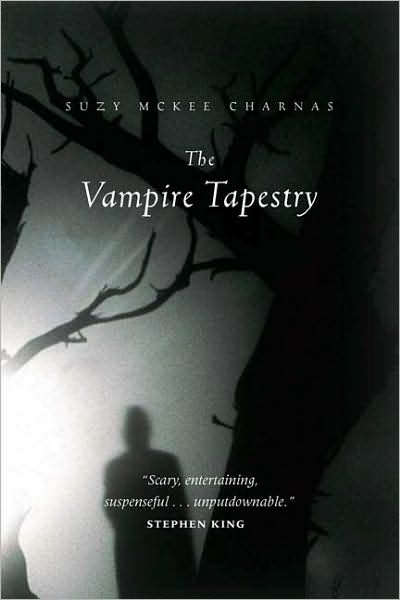While the pop culture push has shifted toward zombies recently, for a while there, it was all about vampires. In fact, I was thoroughly vampired out. They may be one of my favorite mythical/supernatural creatures but there’s only so much one can read of the same-old, same-old without being exhausted by it. Not to mention the lack of ingenuity in the proliferation of new vampire books. (Don’t get me wrong, I love urban fantasy and whatnot, but the cookie-cutter biologies and mythologies get old fast.)
However, I happened across a copy of The Vampire Tapestry at this year’s Readercon—I’d heard quite a bit about this book from different sources, all friends giving me a nudge in Charnas’s direction. It’s hardly new; the book was originally published in 1980, which makes it older than me, and I’m honestly not sure how I missed something so fantastic for so many years. Potentially because I’ve never seen anything by Charnas on bookstore shelves while browsing? I was just unlucky?
As the title implies, this is a book about a vampire at the most base level of its construction. The way Charnas uses the idea of the vampire and alters it is one of the more unique aspects of the book—The Vampire Tapestry is almost more science fictional in its representation of “the vampire” than fantastical. Weyland is hardly a supernatural creature. He knows simply that he isn’t a member of the human species, but perhaps some evolution out of it or an alien lifeform altogether. He lives out a lifetime regularly and then falls into a sort of hibernation where the past lifetime is wiped clean from his memory except in the most vague of senses. His psychological state and the development of his identity and awareness of the world around him come to peak points as he interacts with regular people. He loses more and more of his stance as predator and slips into a less comfortable, more tenuous role.
That might not sound too unique, though—the exploration of the relationship between predator and prey when they wear the same faces is something every genre of fiction plays with. What makes The Vampire Tapestry so amazing is its word-by-word construction and the narratives it strings together. It isn’t a vampire novel so much as it is a book of psychological study, of people brushing by each other like ships in the night, and of the fragility of the world around us. The scope of the book is small, its cast is also limited—that doesn’t stop it from tackling a thematic idea that will leave the reader quietly breathless by the end.
I admit that when I read, I don’t just read to be told a story, but also to deconstruct that story and the way it was put together. I derive as much pleasure from how I’m being told a tale as I do from the tale itself; they thrive equally together in a really great book, after all. Charnas has a way with words that I can only describe as precise. Each choice of word, each sentence, each paragraph and each separate chunk of the book work together in a harmony that is almost, but never quite fully, dissonant.
On top of the lyricism and imagery Charnas wields, I have a weakness for stories made up of other stories. There are five separate novellas that form the actual “book” of The Vampire Tapestry, each told from the perspectives of different characters with different slices of the world to their name as they encounter Weyland—finally culminating in a story from Weyland himself.
It’s a book I’d tell everyone to read not just because it’s one of the best books about a “vampire” I’ve ever come upon. I mean, yes, that’s a great reason to pick it up. It’s unique, it plays with the traditional mythology so intensely that it barely resembles itself anymore, and it’ll give you the chills here and there. The real wealth of The Vampire Tapestry doesn’t lie only in how far it stands out above the rest of those-books-about-vampires, though.
It’s just that good of a book. The writing is enthralling. The characters are flawed and real, painfully so in every case—they are generally people who are unhooked from the world around them in some way, who aren’t quite part of it, and not in the dramatic gothic sense. Katje is alone and alien in a country that feels all wrong to her after the death of her husband—which isn’t to say that she’s entirely sympathetic, because she’s a bit wince-inducing. Mark is a world in and of himself as an intensely smart but also intensely lonely teenager whose situation struck me to the heart. And then you have Floria and her eventual, strange relationship with Weyland that helps her reorder her collapsing life. Irv, too, whose story ends in a very definite way that Weyland can’t quite grasp.
Trust me on this one—pick up The Vampire Tapestry if you’ve managed to miss it along the way, like I did. It’s a ridiculously excellent book. (And you can bet I’m going to be looking for more of Charnas from now on.)
Lee Mandelo is a multi-fandom geek with a special love for comics and queer literature. She can be found on Twitter and Livejournal.










